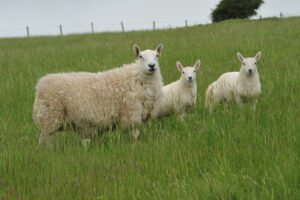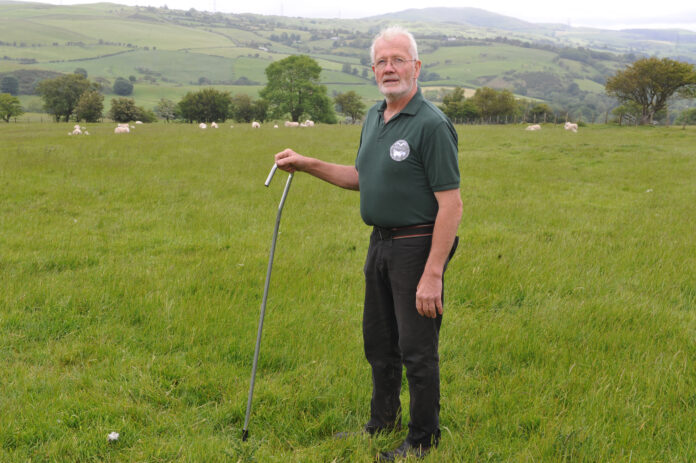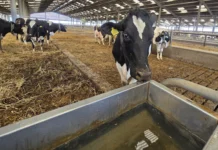In five years, the average weight of lamb produced per ewe in Elfyn Owen’s flock has increased by 9.3kg, to 47.6kg.
Mr Owen, who farms with his wife, Ruth, recognised the value of achieving genetic gains driven through estimated breeding values (EBVs) long before he started recording the pure-bred Welsh Mountain Cernyw flock in 2019.
He had been performance recording his Cernyw Bluefaced Leicester flock since 1997 and, at 36.7mm, that flock’s EBV for muscle depth is the highest ever recorded in the breed.
“It was a natural progression to record the Welsh ewes when we had the chance to join the Hill Ram Scheme in 2019 and then Tier 1 of Farming Connect’s Welsh Sheep Genetics Programme (WSGP),” says Mr Owen, who is national chair of the Bluefaced Leicester Sheep Breeders’ Association.
The Bluefaced Leicester flock is now included in Tier 2 of the WSGP.
Mr Owen runs a flock of 480 Welsh Mountain ewes and 70 Bluefaced Leicesters at Ffrith Arw, near Llanrwst, producing lambs solely from grazed grass and marketing recorded sires and replacement ewes at breed sales while also selling fat lambs into the liveweight and deadweight markets.
He has been breeding the Llandovery Whiteface-type ewe since the end of the 1970s as it is well matched to the conditions at Ffrith Arw.
“The sheep have good skins, good wool on them, they suit our system of producing lamb entirely from grass,” he says.
Two hundred of the Welsh ewes are recorded using DNA parentage techniques because of the extensive nature of the system.
This technique is 50:50 funded by the WSGP and Mr Owen.
The ewes are condition scored and weighed in the autumn before the tups are turned in in December, at a ratio of one ram to every 50 sheep.
Pregnancy scanning in the 2023 breeding season showed a scanning percentage of 160%, but Mr Owen says he is aiming for 180%.
“For us recording is about prolificacy too, we are not a mountain farm, we are an upland farm with improved land, and want as many lambs as possible.
“We are working on getting two lambs per ewe with improvements in muscle depth, conformation and weight, we have the type of sheep that can make it work.”
The Welsh ewes lamb outdoors in May.
At lambing, the twin-bearing ewes are drafted into one field and their progeny are EID tagged and DNA samples taken from their ears.
The analysis of the DNA is matched to that of the ewes and allows parentage to be assigned.
Lambs are weighed at eight weeks and again at 20 weeks of age.
Having EBVs, which indicate exactly where an animal ranks within the breed for specific traits of economic importance, play an important role in flock profitability, says Mr Owen.
Having those figures allows him to make better breeding decisions, both within his own flock and when breeding rams and replacements for his customers.
Since Mr Owen started recording the flock in 2019, eight-week weights have increased from -0.19kg to 0.62kg and muscle depth from -0.12 to 0.22; scanning weights have increased by 1.71kg.
“Something is working,” he says.
A major development in June 2023 saw a change to how the hill index is expressed, as £ as the expected annual return per ewe, to provide a way of ranking animals based on the economic merit of their genetics.

Mr Owen’s figures show that in 2020 his flock’s average index was £5.16.
Performance recording had increased this to £10.11 in 2023.
He is not surprised. “We are getting better weights and muscle depth; it is making the ewe more efficient and making her work for us without any concentrates.”
The value in recording is also evident in his sale of stock with his yearling tups averaging £1,000 at the 2023 Prohill sale.
“We appreciate and value the custom of forward-thinking progressive buyers who come to Aberystwyth in search of performance recorded rams,” says Mr Owen.
Each year he uses more of his own recorded tups on his commercial flock too.
Recording is not only helping him to improve his commercial ewes but it is helping the sheep industry overall become more efficient, Mr Owen suggests.
“Progress is what you would call it,” he says. “Livestock farming is so important for Wales, we are grateful that the Welsh Government recognises this and is supporting us with the Farming Connect programme, and the WSGP in particular.”
He sees recording in Welsh hill breeds as one of the tools that will help the industry address some of the challenges ahead.
“Recording may seem time consuming to some but it is time well spent and worth the investment.
“We can only keep sheep or beef on the type of land we have and it is sheep that I am passionate about.”
FARM FACTS
200 acres farmed
Land rising to 1,020 feet
Closed flock since the early 1980s
Set stocking
Fat lambs sold at St Asaph and Ruthin markets and deadweight to Kepak
Lambs sold at 46kg liveweight average
Bluefaced Leicester ewes lamb indoors in February and March
Habitat Wales Scheme agreement
Compound fertiliser only applied to silage fields
PANEL
There are 95 flocks in the WSGP.
In Tier 1 these include Welsh hill and upland breeds of sheep and 46% of those are Welsh Mountain, but with a good cross section of other breeds including Hardy Speckled and Beulah.
There is also a second tier which supports specific maternal breeds, including the Lleyn, Romney, Charmoise Hill and Bluefaced Leicester.
Farming Connect is supported by Innovis and AHDB-Signet to deliver the programme.

| [donate]
| Help keep news FREE for our readersSupporting your local community newspaper/online news outlet is crucial now more than ever. If you believe in independent journalism,then consider making a valuable contribution by making a one-time or monthly donation. We operate in rural areas where providing unbiased news can be challenging. |


















